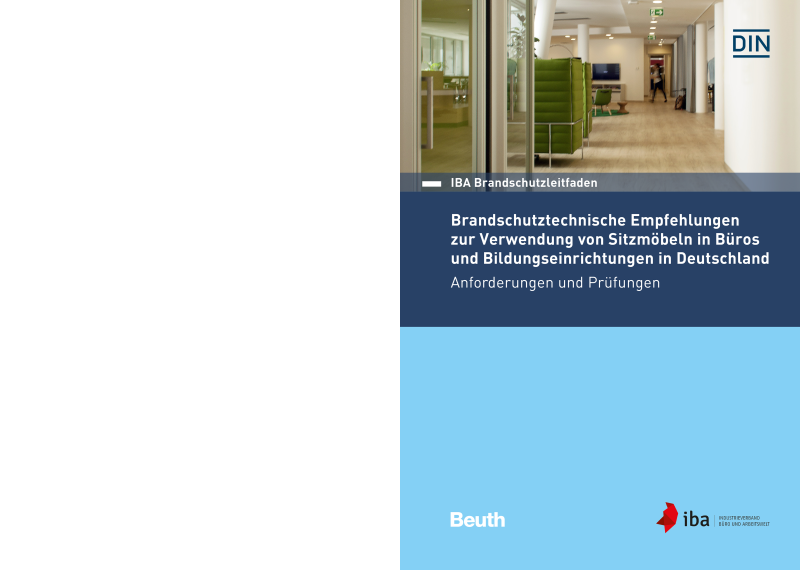Unlike building products, there is currently no comprehensive set of regulations covering fire protection requirements for furniture. For this reason, attempts are often made to transfer requirements and tests for building products to furniture, for example the widely known B1 classification. This, however, is of little practical use. In fact, there are recommendations issued by fire brigades and requirements under workplace legislation that can be applied instead.
All information on this page is based on regulations applicable in Germany. Requirements in other countries may differ.
Protection objectives and basic requirements
In the event of danger, all occupants must be able to leave the premises independently – this also applies to visitors unfamiliar with the building layout. At the same time, fire brigades must be able to reach the source of the fire as quickly as possible. Essential prerequisites include escape and rescue routes of sufficient width, leading directly outdoors. Clear signage is also required.
Details are specified in the state building codes (Landesbauordnungen) and in the Technical Rules for Workplaces (ASR) relating to the Workplace Ordinance (ArbStättV), in particular ASR A2.2 – Measures against fire, ASR A2.3 – Escape routes and emergency exits and ASR V3a.2 – Accessible design of workplaces. Additional requirements may also apply. These must be clarified with the locally responsible approval authorities, usually the fire protection service of professional fire brigades or the district/county building authorities.
Escape routes must be as short as possible, sufficiently wide, and clearly marked.
Requirements for furniture
The requirements regarding the fire behaviour of furniture depend on where it is located.
Furniture in occupied rooms
For furniture in occupied rooms up to a maximum of 1,600 m², no special requirements are stipulated under building regulations. Occupied rooms are defined as rooms “intended or suitable for the non-temporary presence of people.” Offices, meeting rooms, and workshop rooms therefore fall within this category.
Furniture in escape and rescue routes
Different rules apply in the area of escape and rescue routes outside these rooms. To ensure unhindered evacuation in the event of danger, such routes must remain free from objects that could obstruct escape. Placing furniture or other items in escape and rescue routes should therefore generally be avoided.
In open-plan offices, however, it is often difficult to avoid placing furniture, especially seating, in escape and rescue routes. In such cases, exceptions may be tolerated. These must be clarified on a case-by-case basis with the competent building authorities or their appointed representatives, as well as with occupational safety officers.
Recommendations on which items of furniture may be tolerated in which locations have been published by the AGBF (Working Group on Preventive Fire and Hazard Protection) in its Recommendations on Risk Assessment of Fire Loads in Rescue Routes. These state that:
- only non-combustible, permanently fixed furniture should be used in essential stairwells;
- in essential corridors, (seating) furniture may be placed individually, provided frames are fire-retardant and upholstery complies with class P a of DIN 66084.
Where furniture is placed in escape and rescue routes, special requirements apply.
Width of escape routes
Escape routes must not be narrowed by the placement of furniture or other objects. Minimum widths are defined in ASR A2.3 (see section on circulation routes). In addition, the requirements set out in state building codes and the guidance of local building authorities must be observed.
Testing of upholstered furniture
In its recommendations regarding seating placed in escape and rescue routes, the AGBF refers to class P a of DIN 66084. What does this mean?
DIN 66084 (Classification of the burning behaviour of upholstered composites) is a German standard. It defines three test classes:
- Class P‑a is based on a test using a paper cushion. This is placed against the rear edge of the seat cushion and ignited. The spread of flames and the time until they extinguish are assessed. The test was designed for upholstered composites but can also be applied to unupholstered seating.
- Class P‑b is based on European standard DIN EN 1021–2. The ignition source is a gas flame simulating a burning match. This is also known as the match test. Like P a, it was designed for upholstered composites.
- Class P‑c uses cigarettes as the ignition source.
IBA Fire Protection Guidelines
The IBA expert committees, in cooperation with DIN and with support from fire brigade specialists, have compiled the details in a guideline entitled: “Fire protection recommendations for the use of seating in offices and educational facilities in Germany – Requirements and tests.” The guideline comprises three main parts: part 1) Protection objectives, references to relevant regulations, and definition of terms, part 2) Specific requirements for seating, and part 3) Instructions for carrying out tests. Annex A illustrates the application using typical office layouts, and Annex D lists suitable test institutes. The content of the guideline is based on existing regulations and recommendations.
The IBA Fire Protection Guidelines were published in May 2022 by Beuth Verlag (DIN Media) and can be ordered there at a price of €24.80 incl. VAT.
(available in German only)





